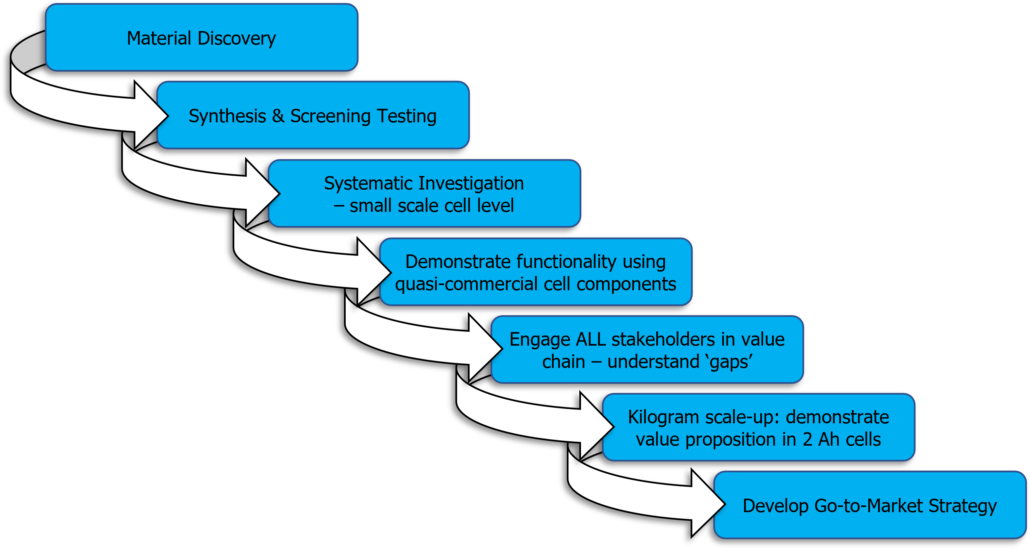The Time Is Right to Focus on Developing New Battery Material Chemistries
The Time Is Right to Focus on Developing New Battery Material Chemistries
Key Points:
- Global push to establish a battery manufacturing infrastructure will provide avenues to implement new Advanced Materials
- New battery material chemistries, along with innovative manufacturing methods, can lead to low-cost EV batteries with the desired performance and safety features
- The involvement of stakeholders across the entire value chain, early in the materials development process, can reduce time to market
A Lithium-ion Battery is Only as Good as the Materials in it
In the days when Lithium-ion batteries constituted a fledgling industry, which goes back to the early 1990s, there was just one commercialized cathode chemistry, lithium cobalt oxide (LCO). The cathode is arguably the most important constituent of a battery since all the energy (measured in Wh per kilogram) comes from the cathode. All the other major components – anode, separator, electrolyte, and binder – are enablers and do not contribute to the capacity of the cell. A few years after LCO had been in commercial use, Lithium Nickel Cobalt Aluminum Oxide (NCA) came along. NCA had a structure that was similar in many ways to LCO; the composition allowed NCA to have a higher capacity than LCO on a weight basis. The current state-of-the-art, high-capacity cathode material has manganese in it, in addition to nickel and cobalt (NMC), and there are different grades of NMC, with varying amounts of nickel. It is worth noting that even after thirty years of development, the cathode material structure is not all that different from the original LCO. Over time, we have kept tweaking the cathode chemistry, making incremental improvements. The one exception is Lithium Iron Phosphate (LFP), which has an entirely different crystal structure compared to NMC. After the initial excitement in the late 1990s, and an attempt by companies to commercialize the phosphate chemistry, it was mostly left to languish for a decade until segments of the industry decided to adopt LFP; not for its capacity, but for having the benefit of fewer Electric Vehicle (EV) fires. Additionally, manufacturers and automotive OEMs benefited from the expiration of the original LFP patent.
The anode of a lithium-ion battery has traditionally received lesser attention than the cathode for a few reasons: the capacity of a battery comes from the cathode, and the anode is simply the host to receive the lithium ions coming from the cathode. Graphite, which is the host, is much less expensive than any cathode material and has nearly two times the capacity of the cathode, pound for pound. But graphite weighs less (i.e., it occupies a relatively larger volume). The advent of silicon as an anode has helped in this regard, and these days small amounts of silicon are added to graphite. Still, the state-of-the-art anode is largely comprised of graphite, the same material that was used in the first commercial lithium-ion battery. For sure there have been innovations in processing graphitic materials and enhancements in the capacity utilization, but there has been no fundamental change.
The larger point here is that we have kept grinding away at the same battery chemistry for over three decades now. We never had a lithium battery industry in most parts of the world except Japan, Korea, and later China, which made it difficult to implement new battery material inventions, of which there have been many. Commercial, high-volume manufacturers of both materials and batteries were invariably in Asia, which created a chasm between materials developers and the adopters. But now that is changing, and it is changing rapidly. Every other week there is a new announcement for yet another factory to produce lithium-ion batteries. These factories are presently slated to utilize well proven cathode and anode materials but should provide avenues for adopting new materials down the road.
There is Ample Room for New Battery Material Chemistries in Rechargeable Batteries
The driving force for continuing to advance the field are three-fold: enhance performance (translation: increase the range of an EV); safety (translation: mitigate risk of EV fires); and cost (translation: so the average consumer can afford an EV). Over the past decade, we have advanced the state of the art on all fronts, due in large part to engineering efforts but not so much because of a change in the fundamental battery chemistry.
The driving force for continuing to advance the field are three-fold:
- Enhance Performance (to increase the range of an EV)
- Safety (to mitigate the risk of EV fires)
- Cost (so the average consumer can afford an EV)
Over the past decade, we have advanced the state of the art on all fronts, due in large part to engineering efforts but not so much because of a change in the fundamental battery chemistry.
We have also seen a dramatic reduction in the cost of lithium batteries, at both the cell level and pack level. According to Bloomberg New Energy Forum (BNEF), cell level costs have gone down from over $500/kWh in 2013 to $120/kWh in 2022. The additional cost from packaging the cells into a pack went down by an order of magnitude in the same time period and now accounts for only 20% of the cost of the battery pack. Much of the steep reduction came from economies of scale, with a sharp uptick in both actual and anticipated demand, and companies setting up manufacturing at scale to meet the demand.
Most of the ground-breaking “new battery chemistry” work occurs in university laboratories all over the world. Coming up with and creating fundamentally new materials is perhaps the most challenging aspect of Materials Science and Engineering. Think about it for a second: it is a material that never existed in that form on this planet. The fascinating field of Materials Science and Engineering brings together engineers, physicists, chemists, and sometimes even biologists, as well as scientists with backgrounds in computation and computer simulation. And that is exactly what the Battery Industry needs – teams that create new materials.
There is an opportunity to ‘fundamentally reshape’ the landscape of the rechargeable battery industry, and for the United States it could be an engine of growth for the next couple of decades, just like what the semiconductor industry did for the US economy in the 1990s and 2000s.
Bringing Stakeholders Together Can Shorten Time to Market
At NEI Corporation, we have had the privilege and pleasure to work with many materials innovators and some of the brightest minds in the business. From providing a wide range of off-the-shelf materials that enable our customers’ R&D efforts, to producing specialty and custom materials, we are singularly focused on enabling our customers to commercialize.
Conventional wisdom says that it takes ten to fifteen years for an invention to make its way into a commercial battery. In the past, the concentration of battery manufacturing in one part of the world made the process arduous at the very least, if not impossible. But now, there is an opportunity around the world to shorten the timeframe.
The pathway described below could potentially reduce the time from ‘concept to commercialization’ and allow capital to be effectively deployed toward promising materials. With manufacturing infrastructure in place in all corners of the world, we can nurture new materials technologies where the raw materials are sourced cost effectively. There is a unique processing methodology involved; the material composition is protected by international patent applications, and the new material enables non-traditional cell architectures.

We Will Figure This Out
Materials innovation in the early stages tends to be compartmentalized, serial, and at times a random process. Taking a holistic approach early in the innovation phase (i.e., a parallel path to product development that looks at all aspects of the cell, including compatibility, manufacturability, cost, and safety) could bring the invention closer to reality more quickly.
There are a lot of restrictions to bringing new materials to market, even after a promising chemistry has been identified and proven. Reasonably priced raw materials need to be available; the material needs to be amenable to low-cost production processes, it needs to be safe to be handled in a ‘dry room’ (i.e., in the presence of air), and it should not be in the form of very small particles, as it prevents a lot of material from being packed in a small volume (think volumetric energy density kWh/L). Above all, all materials in a cell need to be compatible with each other.
The time is right for us to take on the challenge of fundamentally transforming the rechargeable battery chemistry so that it can deliver on its promise. Whether it is based on lithium, sodium, or magnesium ion rocking-chair principle, a chemical compound that is vastly different from a metal oxide cathode and graphite anode, could make the battery look very different (from the inside)! With the changing dynamics of the industry, we as industry participants have an opportunity to seize the moment.
 About the Author:
About the Author:
Dr. Ganesh Skandan is the CEO of NEI Corporation and earned his Ph.D. in Materials Science and Engineering from Rutgers – The State University of New Jersey. Shortly after his graduate work, he co-founded NEI Corporation in 1997. In 2003, Dr. Skandan was recognized as an outstanding alumnus of the Graduate School at Rutgers University at its 50th anniversary. In 2011, Rutgers University again recognized his accomplishments with a Distinguished Alumni award for Distinction in the Physical Sciences. Dr. Skandan holds more than a dozen patents.
Contact:
400E Apgar Drive • Somerset, NJ 08873 • USA
gskandan@neicorporation.com
+1 (732) 868-3141
About NEI:
Founded in 1997, NEI develops, manufactures, and sells advanced materials for a broad range of industrial customers around the world. The company’s core competencies are in designing, developing, and producing products that meet the specific application needs of its customers. More importantly, NEI is a solutions provider, working closely with customers to produce and implement materials for their applications. NEI’s products, which are sold under the registered trademark NANOMYTE®, are backed by a suite of issued and pending patents. NEI’s products include: Lithium-ion Battery Materials, Na-ion Battery Materials, Functional & Protective Coatings, and Specialty Nanoparticle-based products. NEI also offers associated materials characterization and testing services.
For more information, give us a call or email us.

